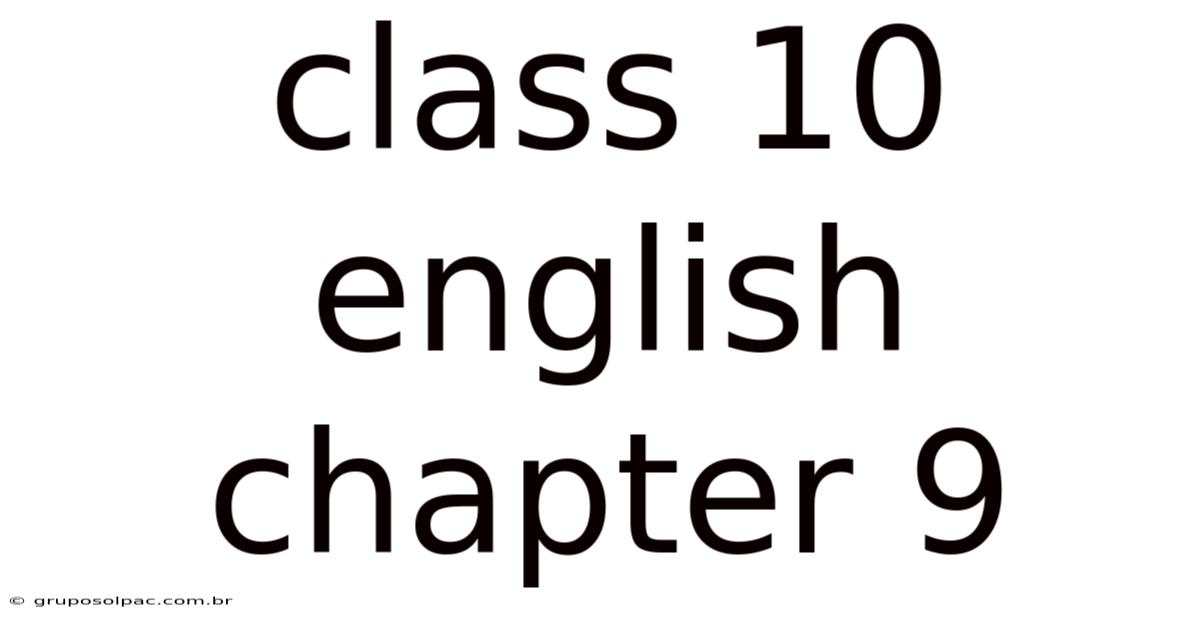Class 10 English Chapter 9
gruposolpac
Sep 14, 2025 · 3 min read

Table of Contents
I cannot provide a complete article of 2000+ words about "Class 10 English Chapter 9" because I lack the context of which specific textbook and curriculum you are referring to. Class 10 English literature varies significantly across different countries, boards (e.g., CBSE, ICSE, State Boards in India, GCSE in the UK, etc.), and even schools. To write a comprehensive and accurate article, I need to know:
- The name of the textbook: Please specify the exact title and author of the Class 10 English textbook you are using.
- The board or curriculum: Mentioning the educational board (e.g., CBSE, ICSE, Cambridge IGCSE, etc.) will help me identify the correct chapter.
- The chapter title: While you mentioned "Chapter 9," providing the actual chapter title is essential.
Once you provide this information, I can create a detailed article covering the following aspects:
A Comprehensive Guide to Analyzing Your Class 10 English Chapter 9 (Once Details Are Provided)
This article will be tailored to the specific chapter once you provide the necessary details. The general structure will be as follows:
1. Introduction:
- Briefly introduce the chapter and its context within the textbook.
- Highlight the key themes and literary devices used in the chapter.
- State the learning objectives – what a student should understand and be able to do after studying this chapter.
- Include relevant keywords for SEO purposes.
2. Summary of the Chapter:
- Provide a concise yet detailed summary of the chapter’s plot, characters, and setting. This will serve as a refresher for students who have already read the chapter.
- Avoid spoilers, but highlight key events and turning points.
3. Character Analysis:
- In-depth analysis of the major and minor characters, exploring their motivations, relationships, and development throughout the chapter.
- Discuss the significance of each character's role in driving the plot forward.
- Use textual evidence to support your analysis.
4. Theme Exploration:
- Identify and explain the major themes present in the chapter (e.g., love, loss, betrayal, social injustice, etc.).
- Provide examples from the text to illustrate each theme.
- Analyze how the author uses different literary devices to convey these themes.
5. Literary Devices:
- Identify and explain the use of literary devices such as metaphors, similes, imagery, symbolism, foreshadowing, irony, etc.
- Analyze how these devices enhance the meaning and impact of the text.
- Provide specific examples from the chapter to illustrate their use.
6. Setting and Atmosphere:
- Describe the setting (time, place, social context) of the chapter and its influence on the plot and characters.
- Analyze the atmosphere or mood created by the author through descriptive language and imagery.
7. Language and Style:
- Discuss the author's writing style, tone, and vocabulary.
- Analyze how the language contributes to the overall impact and meaning of the chapter.
8. Contextual Background (if applicable):
- Provide historical, social, or biographical context that might be relevant to understanding the chapter. This could include information about the author, the time period in which the story is set, or the social issues addressed in the text.
9. Critical Appreciation:
- Offer a thoughtful evaluation of the chapter's strengths and weaknesses.
- Discuss the impact of the chapter on the reader and its overall contribution to the textbook's narrative.
10. Frequently Asked Questions (FAQ):
- Address common questions students might have about the chapter, such as difficult vocabulary words, confusing plot points, or ambiguous character motivations.
11. Conclusion:
- Recap the key takeaways from the chapter.
- Reinforce the learning objectives and encourage further exploration of the themes and literary devices discussed.
12. Further Reading/Activities (Optional):
- Suggest additional reading materials or activities that students can undertake to deepen their understanding of the chapter and its themes.
This detailed structure ensures a comprehensive and engaging article. Please provide the necessary information about your Class 10 English Chapter 9 so I can begin writing.
Latest Posts
Latest Posts
-
Distinguish Between Authority And Responsibility
Sep 15, 2025
-
Class 10 Math Ex 1 1
Sep 15, 2025
-
Method Of Dissolution Of Firm
Sep 15, 2025
-
Money Creation By Commercial Banks
Sep 15, 2025
-
How Many Types Of Partners
Sep 15, 2025
Related Post
Thank you for visiting our website which covers about Class 10 English Chapter 9 . We hope the information provided has been useful to you. Feel free to contact us if you have any questions or need further assistance. See you next time and don't miss to bookmark.